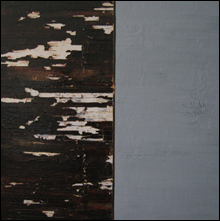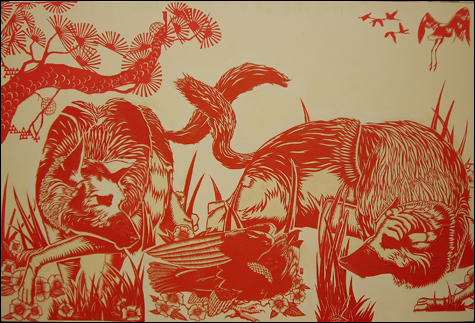Compelling new work by Neal T. Walsh and William Schaff
By GREG COOK | April 15, 2008

POWERFUL: Walsh’s The Clearing. |
Providence artist Neal Walsh’s great new abstract paintings bring to mind peeling paint, rust, and cracking plaster in old mills or houses, maybe the wall in the hall of an apartment building. On view at 5 Traverse gallery — along with work by Warren’s William Schaff — they embody the romance of ruins, capturing a particularly Providence love of old buildings and their majestic rot. But they also reach toward humanity’s ancient awe of ruins from Egypt to Greece to Mexico — to Edward Hopper’s sagging Victorian homes and tired city streets.
Walsh, the gallery director at AS220, corrals these textures and moods into squares and rectangles and grids painted on canvas and plywood. Whitebreakers (2006) looks like an old white plaster wall scratched and weathered until old layers of red, green, and cream paint underneath show through. The left two-thirds of Without Notice (2008) looks as if rusty water has puddled atop some crusty crud — actually bits of pigment and gold leaf. A stained and speckled square of rumpled newspaper fills the upper right corner. Below it, Walsh painted a rectangle of yellow ochre with a crisp left edge where it overlaps the brown. Notice his careful attention to edges. Sometimes he doesn’t quite paint to the edge, so things raggedly trail off, revealing the history of his process in overlapping layers of paint. Sometimes he paints a hard stripe along the edge that asserts itself like the period at the end of a sentence.
These are slow-burn, elegantly composed, meditative abstractions by an artist clearly in full command of his craft. My only hesitation is, could they be too tasteful? Walsh’s style is rooted in American abstract painting of the ‘40s to ’60s. He tells me that one inspiration is Matt McCormick’s 2001 documentary film The Subconscious Art of Graffiti Removal, which half-jokingly compares the patchwork shapes of painted-over graffiti to Mark Rothko paintings. Walsh’s stripes recall Barnett Newman and Richard Diebenkorn. (For Walsh, the lines and sections symbolize the transitions and divisions between one part of your life and the next.) A grid brings to mind Agnes Martin.

A MYSTERIOUS TOUR DE FORCE: Schaff’s Cornered Eagle. |
The best of the group is The Clearing (2008). The painting is divided in two by a green vertical stripe. The left half is root beer brown laid down in thick rippling horizontal stripes. It’s apparently a concoction of wax, oil paint, tape, epoxy, and perhaps ash that Walsh applied, scraped off, and then built up again. He probably burned parts with a torch, and then chipped, scratched, and cut at the surface. Parts have fallen off, like paint or plaster flaking off an old building, to reveal white and violet paint underneath. The right side is pale gray-blue, dinged and dented, with scratches revealing dark blue or black underneath. It looks like an old battered wall that’s been painted over and over. The magic is how Walsh transforms texture into memory. Maybe a palm reader could exactly explain the history and nostalgia etched into each wrinkle and scar but, man, it adds up to powerful stuff.
Schaff, who plays drums (and wears a chimp mask) in Providence’s What Cheer? Brigade marching band, exhibits surreal expressionist illustrationy drawings, paintings, scratchboards, embroideries, and papercuts. A diorama features flat overlapping cut-out drawings of a bird shot with arrows falling out of a cloudy sky. In a scratchboard drawing, men puke up naked bodies, which are swallowed by a bearded Jesus who washes the men’s feet. Schaff has honed a sharp dramatic style, but the cumulative effect of all the hollow eyes, crooked bodies, and dark goings-on can feel over the top. But check out Cornered Eagle (2008), a tour de force red papercut scene on cream plywood of a pair of German shepherds circling a grounded eagle. A curling calligraphic branch at left and what appear to be herons flapping away at right give it the feel of traditional Asian art — you might call it neo-Japonisme. Schaff’s craft — in the patterns of the dogs’ fur, the tree’s fish-scale bark, the birds’ plumage — dazzles. And the mystery of the action — it feels like some ritual dance — lingers in the mind.
Neal T. Walsh + William Schaff | 5 Traverse, 5 Traverse Street, Providence | Through May 3
 Related
Related:
 Topics
Topics:
Museum And Gallery
, Neal Walsh
, William Schaff
, Painting
, More  , Neal Walsh
, William Schaff
, Painting
, Visual Arts
, Edward Hopper
, Barnett Newman
, Mark Rothko
, Richard Diebenkorn
, Agnes Martin
, Less
, Neal Walsh
, William Schaff
, Painting
, Visual Arts
, Edward Hopper
, Barnett Newman
, Mark Rothko
, Richard Diebenkorn
, Agnes Martin
, Less 